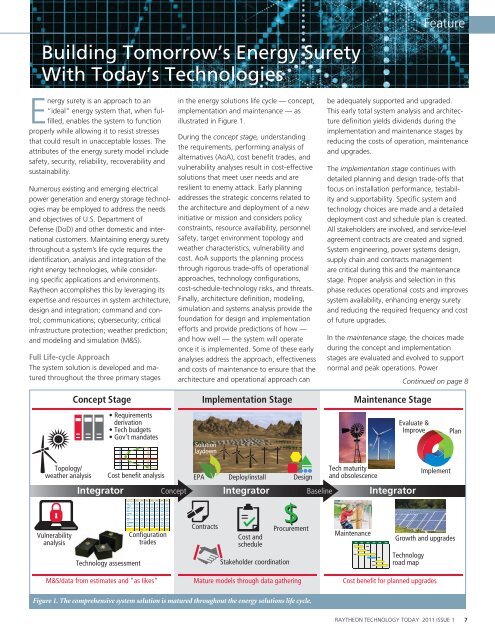Raytheon Technology Today 2011 Issue 1
Raytheon Technology Today 2011 Issue 1
Raytheon Technology Today 2011 Issue 1
Create successful ePaper yourself
Turn your PDF publications into a flip-book with our unique Google optimized e-Paper software.
Building Tomorrow’s Energy Surety<br />
With <strong>Today</strong>’s Technologies<br />
Energy surety is an approach to an<br />
“ideal” energy system that, when fulfilled,<br />
enables the system to function<br />
properly while allowing it to resist stresses<br />
that could result in unacceptable losses. The<br />
attributes of the energy surety model include<br />
safety, security, reliability, recoverability and<br />
sustainability.<br />
Numerous existing and emerging electrical<br />
power generation and energy storage technologies<br />
may be employed to address the needs<br />
and objectives of U.S. Department of<br />
Defense (DoD) and other domestic and international<br />
customers. Maintaining energy surety<br />
throughout a system’s life cycle requires the<br />
identification, analysis and integration of the<br />
right energy technologies, while considering<br />
specific applications and environments.<br />
<strong>Raytheon</strong> accomplishes this by leveraging its<br />
expertise and resources in system architecture,<br />
design and integration; command and control;<br />
communications; cybersecurity; critical<br />
infrastructure protection; weather prediction;<br />
and modeling and simulation (M&S).<br />
Full Life-cycle Approach<br />
The system solution is developed and matured<br />
throughout the three primary stages<br />
Topology/<br />
weather analysis<br />
Vulnerability<br />
analysis<br />
Concept Stage<br />
• Requirements<br />
derivation<br />
• Tech budgets<br />
• Gov’t mandates<br />
Cost benefit analysis<br />
<strong>Technology</strong> assessment<br />
Configuration<br />
trades<br />
in the energy solutions life cycle — concept,<br />
implementation and maintenance — as<br />
illustrated in Figure 1.<br />
During the concept stage, understanding<br />
the requirements, performing analysis of<br />
alternatives (AoA), cost benefit trades, and<br />
vulnerability analyses result in cost-effective<br />
solutions that meet user needs and are<br />
resilient to enemy attack. Early planning<br />
addresses the strategic concerns related to<br />
the architecture and deployment of a new<br />
initiative or mission and considers policy<br />
constraints, resource availability, personnel<br />
safety, target environment topology and<br />
weather characteristics, vulnerability and<br />
cost. AoA supports the planning process<br />
through rigorous trade-offs of operational<br />
approaches, technology configurations,<br />
cost-schedule-technology risks, and threats.<br />
Finally, architecture definition, modeling,<br />
simulation and systems analysis provide the<br />
foundation for design and implementation<br />
efforts and provide predictions of how —<br />
and how well — the system will operate<br />
once it is implemented. Some of these early<br />
analyses address the approach, effectiveness<br />
and costs of maintenance to ensure that the<br />
architecture and operational approach can<br />
Figure 1. The comprehensive system solution is matured throughout the energy solutions life cycle.<br />
EPA<br />
Deploy/install Design<br />
Feature<br />
be adequately supported and upgraded.<br />
This early total system analysis and architecture<br />
definition yields dividends during the<br />
implementation and maintenance stages by<br />
reducing the costs of operation, maintenance<br />
and upgrades.<br />
The implementation stage continues with<br />
detailed planning and design trade-offs that<br />
focus on installation performance, testability<br />
and supportability. Specific system and<br />
technology choices are made and a detailed<br />
deployment cost and schedule plan is created.<br />
All stakeholders are involved, and service-level<br />
agreement contracts are created and signed.<br />
System engineering, power systems design,<br />
supply chain and contracts management<br />
are critical during this and the maintenance<br />
stage. Proper analysis and selection in this<br />
phase reduces operational costs and improves<br />
system availability, enhancing energy surety<br />
and reducing the required frequency and cost<br />
of future upgrades.<br />
In the maintenance stage, the choices made<br />
during the concept and implementation<br />
stages are evaluated and evolved to support<br />
normal and peak operations. Power<br />
Implementation Stage Maintenance Stage<br />
Solution<br />
laydown<br />
Tech maturity<br />
and obsolescence<br />
Integrator Concept Integrator Baseline Integrator<br />
Contracts Procurement<br />
Cost and<br />
schedule<br />
Stakeholder coordination<br />
Maintenance<br />
Continued on page 8<br />
Evaluate &<br />
Improve Plan<br />
Growth and upgrades<br />
<strong>Technology</strong><br />
road map<br />
M&S/data from estimates and “as likes” Mature models through data gathering Cost benefit for planned upgrades<br />
$<br />
Implement<br />
RAYTHEON TECHNOLOGY TODAY <strong>2011</strong> ISSUE 1 7

















